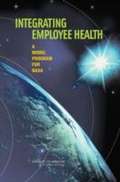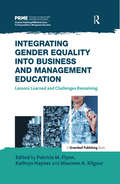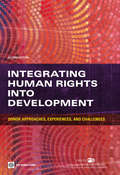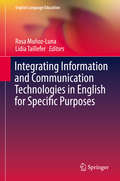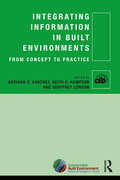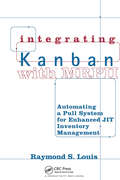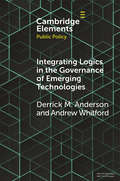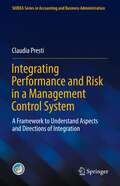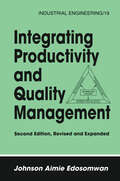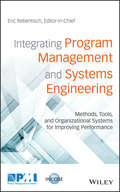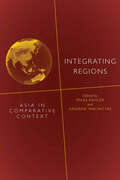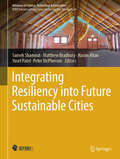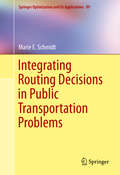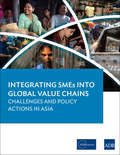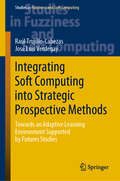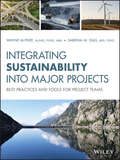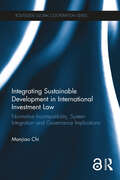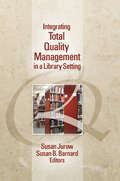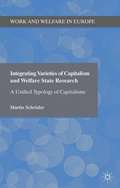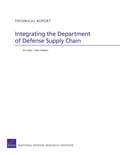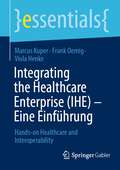- Table View
- List View
Integrating Employee Health: A Model Program For Nasa
by Institute of Medicine of the National AcademiesThe American workforce is changing, creating new challenges for employers to provide occupational health services to meet the needs of employees. The National Aeronautics and Space Administration (NASA) workforce is highly skilled and competitive and employees frequently work under intense pressure to ensure mission success. The Office of the Chief Health and Medical Officer at NASA requested that the Institute of Medicine review its occupational health programs, assess employee awareness of and attitude toward those programs, recommend options for future worksite preventive health programs, and ways to evaluate their effectiveness. The committee’s findings show that although NASA has a history of being forward-looking in designing and improving health and wellness programs, there is a need to move from a traditional occupational health model to an integrated, employee-centered program that could serve as a national model for both public and private employers to emulate and improve the health and performance of their workforces.
Integrating Europe's Financial Markets
by Jörg Decressin Hamid Faruqee Wim FonteyneThis publication traces the European Union's journey along the path to a single financial market and identifies the challenges and priorities that remain ahead. It examines recent integration efforts in the EU following the introduction of the euro, the importance of financial integration for economic growth, the interplay between banks and markets, and equity market integration, as well as the relationship between financial integration and financial stability.
Integrating Gender Equality into Business and Management Education: Lessons Learned and Challenges Remaining
by Kathryn Haynes Patricia M. Flynn Maureen A. KilgourThis volume addresses the need to integrate gender equality into business and management education and provides examples of leading initiatives illustrating how this can occur from various disciplinary and global perspectives. Gender inequality has a long history in business schools and the workplace, and traditions are hard to change. Some disciplines remain resolutely gendered, affecting both women and men; and case materials on women leaders and managers are still rare.The chapters provide conceptual and research rationales as to why responsible management education must address the issue of gender equality. They also identify materials and resources to assist faculty in integrating gender issues and awareness into various disciplines and fields. These include specific case studies and innovations that assess or address the role of gender in various educational environments.The book is designed to help faculty integrate the topic of gender equality into their own teaching and research and gain support for the legitimacy of gender equality as an essential management education topic. This is the first book in a series on gender equality as a challenge for business and management education, published with the Principles of Responsible Management Education (PRME) Working Group on Gender Equality.
Integrating Human Rights into Development
by World Bank OecdThe past two decades have witnessed a convergence between human rights and development, particularly at the level of international political statements and policy commitments. This phenomenon is captured in milestones such as the 2007 OECD DAC Action Oriented Policy Paper on Human Rights and Development (â œAOPPâ ?), the 2010 UN World Summit Outcome Document, the commitments of the 2005 and 2011 High-Level For an Aid Effectiveness in Accra and Busan. The connections between rights violations, poverty, exclusion, environmental degradation, vulnerability and conflict continue to be explored and better understood. More positively, there is growing recognition of the intrinsic importance of human rights in a range of contexts, as well as their potential instrumental relevance for improving development processes and outcomes. This second edition of Integrating Human Rights into Development: Donor Approaches, Experiences and Challenges consolidates the research and findings complied in 2006 with relevant developments that have occurred in the intervening six years. It brings together the key political and policy statements of recent years with a discussion of the approaches and experiences of bilateral and multilateral agencies engaged in integrating human rights in their development cooperation activities in a variety of ways. Despite rapid changes in the donor landscape and acute budget pressures resulting from the financial crisis, the experience of the past six years also attests to the sustained commitment of OECD member countries and multilateral donors to engage with human rights strategically, as a means for improving the ways they deliver and manage aid and the quality of development co-operation.
Integrating Information and Communication Technologies in English for Specific Purposes (English Language Education #10)
by Rosa Muñoz-Luna Lidia TailleferThis book fills the need for a text that integrates Information and Communication Technologies (ICTs) into English for Specific Purposes (ESP). It offers insights on current methodological principles in ESP in both academic and professional contexts, drawing on authentic teaching and learning situations, and analyses best practice guidelines. Part I begins with ESP pedagogical principles and technological practice in order to focus on its two main branches: English for Academic Purposes, which includes linguistic skills and students’ needs, and English for Occupational Purposes, specifically looking at Business, Medical and Translators courses. This book is a great resource for ESP researchers, educators and students, because it provides case studies of how ICTs can be used in English for multiple purposes. Authors present their experiences of integrating tools into their instructions, with each chapter contributing unique pedagogical implications.
Integrating Information in Built Environments (Cib Ser.)
by Adriana X Sanchez Keith Hampson Geoffrey LondonIn an increasingly globalised built environment industry, achieving higher levels of integration across organisational and software boundaries can lead to improved economic, social and environmental outcomes. This book is the direct result of a collaborative global network of industry and academic researchers spread across nine countries as part of CIB’s (International Council for Research and Innovation in Building and Construction) Task Group 90 (TG90) Information Integration in Construction (IICON). The book provides a broad view of some of the opportunities and challenges brought by integrating information across organisational and system boundaries in the built environment industry. Chapters cover a large range of topics and are separated into three sections: resources, processes and added value. They provide a much-needed international perspective on a current global evolution in the industry and present leading original research and valuable lessons for researchers, industry practitioners, government clients and policy makers across the industry. Key features include: a broad range of topics that are not covered elsewhere in the literature; contributions from a diverse group of industry research leaders from across the globe; exemplar case studies providing real-world examples of where information integration has been a key factor for success or lack thereof has been at the root cause of failure; an analysis of future priority areas for research and development investment as well as their strategic implications for public and private decision-makers; the book will deliver innovation in best practice methodology for information sharing across disciplines and between the design, construction and asset management sectors.
Integrating Kanban with MRP II: Automating a Pull System for Enhanced JIT Inventory Management
by Raymond S. LouisToyota Production System methods have rendered remarkable results in high-volume manufacturing plants, but they have not been fully understood and correctly applied in high-mix, low-volume environments. While lean principles do apply, the implementation methods and tools must be adapted and alternate methods embraced in a low-volume environment. This volume is specifically geared for manufacturers that have hundreds to thousands of active part numbers with few or no ongoing forecasted volumes, and for job shops that build only to order. The primary focus is eliminating non-value-added activities and instituting improvements on the most repetitive jobs, a strategy that gives you more time to produce your low-volume work or one-offs.About the author: Greg Lane is a faculty member of the Lean Enterprise Institute and an advisor to the Instituto de Lean Management in Spain. During his time with Toyota, he was one of ahandful of candidates selected for a one-year training program conducted by the company‘s masters. He became certified as a Toyota Production System (TPS) Key Person and continued his work with Toyota, training others in TPS. He has been highly active in working on implementing lean around the world, supporting large and small companies alike. In 1998, he began to focus his lean endeavors on meeting the specific needs of high-mix, low-volume enterprises. During his time as an independent consultant, Greg purchased and operated his own manufacturing company, which specialized in fast turnaround on high-mix, low-volume parts. Greg used TPS to grow the business and nearly double its sales. Greg and his associates have experience not only at adapting the methods contained in this book, but also in applying other tools that are too numerous to detail here. They can be reached for further support with your lean transformation via email: glane@lowvolumelean.com
Integrating Logics in the Governance of Emerging Technologies: The Case of Nanotechnology (Elements in Public Policy)
by Derrick Mason Anderson Andrew WhitfordThe governance of emerging technologies does not follow a single governance paradigm because of complex interactions between government, industry, and civil actors. In this Element, we will argue that for emerging technologies, governance is a 'convergent paradigm'. We introduce governance issues associated with emerging technologies generally before turning to the specifics of nanotechnology. We then approach governance theory and practice by considering different perspectives on governance by their different orientations with respect to object and process. Finally, we construct a matrix of object and process oriented governance activities observed in the case of nanotechnology in the United States.
Integrating Performance and Risk in a Management Control System: A Framework to Understand Aspects and Directions of Integration (SIDREA Series in Accounting and Business Administration)
by Claudia PrestiThis book presents a theoretical and empirical framework to interpret the possible configurations of the integration between performance management and risk management systems as part of management control systems. The book provides an overview of the development paths of these three systems, outlining the evolution and the current development of these disciplines, highlighting emerging issues and providing some original considerations. The author uses both an inductive and deductive approach in shaping the proposed framework, and includes the perspective of practitioners and academics on the topic. Based on a multiple case study in listed companies and a survey administered to small and medium enterprises, this book provides readers with valuable insights to adapt the proposed framework in different business contexts.
Integrating Productivity and Quality Management (Industrial Engineering: A Series of Reference Books and Textboo)
by Johnson EdosomwanThis second edition details all productivity and quality methodologies, principles and techniques, and demonstrates how they interact in the three phases of the productivity and quality management triangle (PQMT): measurement, control and evaluation; planning and analysis; and improvement and monitoring. This edition features material on practical
Integrating Program Management and Systems Engineering: Methods, Tools, and Organizational Systems for Improving Performance
by Eric RebentischIntegrate critical roles to improve overall performance in complex engineering projects Integrating Program Management and Systems Engineering shows how organizations can become more effective, more efficient, and more responsive, and enjoy better performance outcomes. The discussion begins with an overview of key concepts, and details the challenges faced by System Engineering and Program Management practitioners every day. The practical framework that follows describes how the roles can be integrated successfully to streamline project workflow, with a catalog of tools for assessing and deploying best practices. Case studies detail how real-world companies have successfully implemented the framework to improve cost, schedule, and technical performance, and coverage of risk management throughout helps you ensure the success of your organization's own integration strategy. Available course outlines and PowerPoint slides bring this book directly into the academic or corporate classroom, and the discussion's practical emphasis provides a direct path to implementation. The integration of management and technical work paves the way for smoother projects and more positive outcomes. This book describes the integrated goal, and provides a clear framework for successful transition. Overcome challenges and improve cost, schedule, and technical performance Assess current capabilities and build to the level your organization needs Manage risk throughout all stages of integration and performance improvement Deploy best practices for teams and systems using the most effective tools Complex engineering systems are prone to budget slips, scheduling errors, and a variety of challenges that affect the final outcome. These challenges are a sign of failure on the part of both management and technical, but can be overcome by integrating the roles into a cohesive unit focused on delivering a high-value product. Integrating Program Management with Systems Engineering provides a practical route to better performance for your organization as a whole.
Integrating Regions: Asia in Comparative Context
by Andrew Macintyre Miles KahlerThe proliferation of regional institutions and initiatives in Asia over the past decade is unmatched in any other region of the world. The authors in this collection explore the distinctive features of these institutions by comparing them for the first time to the experience of other regions; from the elaborate institution-building of Europe to the more modest regional projects of the Americas. It is an opportune moment for this reassessment, as the European regional model faces a sovereign debt crisis while Asian economies see more secure sources of growth from their immediate neighbors. Asias regional institutions display a distinctive combination of decision rules, commitment devices, and membership practices, shaped by underlying features of the region, the dynamics of regional integration, and the availability of institutional substitutes. Within this context, the authors propose changes that will better sustain the prosperity and peace that have marked Asia in recent decades.
Integrating Resiliency into Future Sustainable Cities (Advances in Science, Technology & Innovation)
by Matthew Bradbury Hasim Altan Sameh Shamout Yusef Patel Peter McPhersonExplore the forefront of urban resilience and sustainability with this groundbreaking collection of research and insights. From the 5th edition of the Resilient and Responsible Architecture and Urbanism (RRAU) conference, this book brings together diverse perspectives and innovative solutions for building resilient and sustainable cities of the future. Featuring contributions from leading scholars, practitioners, and policymakers, this book delves into the multifaceted dimensions of urban resilience at the city, community, and architectural scales. Discover case studies and research on smart urban furniture, medium-density urban planning, crime and urban resilience, green and cool roofs for extreme heat mitigation, and more. Dive into discussions on enhancing social resilience post-COVID-19, urban acupuncture theory for pandemic effects on public spaces, and street retrofitting interventions to boost community resilience. Explore resilient infrastructures, sustainable architectural design principles, and innovative approaches to construction waste management for a more sustainable future. This book serves as an invaluable resource for architects, urban planners, policymakers, researchers, and students interested in shaping the future of our cities. Whether you're seeking practical solutions or theoretical insights, "Integrating Resiliency into Future Sustainable Cities" offers a comprehensive overview of the latest advancements in resilient and sustainable urban development.
Integrating Routing Decisions in Public Transportation Problems
by Marie E. SchmidtThis book treats three planning problems arising in public railway transportation planning: line planning, timetabling, and delay management, with the objective to minimize passengers' travel time. While many optimization approaches simplify these problems by assuming that passengers' route choice is independent of the solution, this book focuses on models which take into account that passengers will adapt their travel route to the implemented planning solution. That is, a planning solution and passengers' routes are determined and evaluated simultaneously. This work is technically deep, with insightful finding regarding complexity and algorithmic approaches to public transportation problems with integrated passenger routing. It is intended for researchers in the fields of mathematics, computer science, or operations research, working in the field of public transportation from an optimization standpoint. It is also ideal for students who want to gain intuition and experience in doing complexity proofs and designing polynomial-time algorithms for network problems. The book models line planning, timetabling and delay management as combined design and routing problems on networks. In a complexity analysis, the border between NP-hard and polynomially solvable problems is illustrated. Based on that, the insights gained are used to develop solution approaches for the considered problems. Besides integer programming formulations, a heuristic method iterating planning and routing step is proposed to solve the problems.
Integrating SMEs into Global Value Chains: Challenges and Policy Actions in Asia
by Adbi AdbGlobalized production networks, or global value chains, provide an opportunity for SMEs to upscale their business models and to grow across borders. This process can enhance SME competitiveness, create more jobs, and promote inclusive growth in developing Asia. The Asian Development Bank (ADB) and the ADB Institute (ADBI) recognize the importance of integrating SMEs into global value chains. To provide pathways for such integration, this study examines ways of encouraging participation in value chains, and explores policy solutions to address the financial and nonfinancial barriers faced by these enterprises.
Integrating Safety and Security Management to Protect Chemical Industrial Areas from Domino Effects (Springer Series in Reliability Engineering)
by Ming Yang Genserik Reniers Chao ChenThis book provides insight into domino effects in industrial chemical sites and process industries. It is about the integration of safety and security resources to prevent and mitigate domino effects in the process industries. It explains how chemical industrial areas, comprised of various hazardous installations, are susceptible to a chain of undesired events, or domino effects, triggered by accidental events or intentional attacks and then presents solutions to prevent them. Firstly, the book provides a dynamic graph approach to model the domino effects induced by accidental fire or intentional fire, considering the spatial-temporal evolution of fires. Then, a dynamic risk assessment method based on a discrete dynamic event tree is proposed to assess the likelihood of VCEs and the vulnerability of installations, addressing the time dependencies in vapor cloud dispersion and the uncertainty of delayed ignitions. A dynamic methodology based on dynamic graphs and Monte Carlo is provided to assess the vulnerability of individuals and installations exposed to multi-hazards, such as fire, explosion and toxic release during escalation events. Based on these domino effect models, an economic approach is developed to integrate safe and security resources, obtaining the most cost–benefit protection strategy for preventing domino effects. Finally, a resilience-based approach is provided to find out the most cost-resilient way to protect chemical industrial areas, addressing possible domino effects. This integrated approach will be of interest to researchers, industrial engineers, chemical engineers and safety managers and will help professionals to new solutions in the area of safety and security.
Integrating Social Media into Information Systems: Requirements, Gaps, and Potential Solutions (G - Reference, Information and Interdisciplinary Subjects)
by Parisa Roshan Isaac R. Porche III Ryan Andrew Brown Astrid Stuth Cevallos Osonde A. Osoba Joshua Mendelsohn Douglas Douglas Yeung John Bordeaux Timothy R. Gulden Laura Kupe Luke J. Matthews Katharine Sieck Sarah SolimanThis report examines the technical challenges associated with incorporating bulk, automated analysis of social media information into procedures for vetting people seeking entry into the United States. The authors identify functional requirements and a framework for operational metrics for the proposed social media screening capabilities and provide recommendations on how to implement those capabilities.
Integrating Soft Computing into Strategic Prospective Methods: Towards an Adaptive Learning Environment Supported by Futures Studies (Studies in Fuzziness and Soft Computing #387)
by José Luis Verdegay Raúl Trujillo-CabezasThis book discusses how to build optimization tools able to generate better future studies. It aims at showing how these tools can be used to develop an adaptive learning environment that can be used for decision making in the presence of uncertainties. The book starts with existing fuzzy techniques and multicriteria decision making approaches and shows how to combine them in more effective tools to model future events and take therefore better decisions. The first part of the book is dedicated to the theories behind fuzzy optimization and fuzzy cognitive map, while the second part presents new approaches developed by the authors with their practical application to trend impact analysis, scenario planning and strategic formulation. The book is aimed at two groups of readers, interested in linking the future studies with artificial intelligence. The first group includes social scientists seeking for improved methods for strategic prospective. The second group includes computer scientists and engineers seeking for new applications and current developments of Soft Computing methods for forecasting in social science, but not limited to this.
Integrating Sustainability Into Major Projects: Best Practices and Tools for Project Teams
by Wayne McPhee Sabrina M. DiasA practitioner-focused guide featuring tools, models, and experience from the front lines of sustainability management on major projects With the growing need for sustainability management on large resource, infrastructure and power projects, this book provides project teams and sustainability practitioners with the practical advice, tools, and resources they need to create better projects. It offers extensive guidance for integrating sustainability into project design, planning and delivery. In each chapter, the authors provide invaluable sustainability management strategies and sample tools for project execution plans, engineering decision-making, stakeholder engagement tracking, logging commitments and follow-up actions, permit tracking, and construction management. Integrating Sustainability into Major Projects: Best Practices and Tools for Project Teams begins by introducing readers to the topic, as well as the common terminology. It then offers readers an overview of major projects, covering types of projects and project structures, the key players, and how to understand and manage different perspectives of time and space. Next, it looks at standards and guidelines, followed by chapters on: Project Management; Managing Risk and Opportunity; Sustainability Management Tools; Approvals and Permits; Design; Procurement; Construction Management; Commissioning; and more. This book: Provides analysis tools and resources that practitioners and project teams can use to successfully integrate and manage sustainability into major project design and delivery including industrial, resource, power, and infrastructure projects; Guides readers on how to work with local communities, engage with stakeholders and develop sustainability programs that support project financing; Includes case studies, lessons learned and expertise from a wide range of actual major projects and the authors' professional experiences with integrating sustainability; Leads practitioners through the major project types and their typical components, structure, and timelines, and demonstrates how sustainability can be effectively integrated into each type of major project. Integrating Sustainability into Major Projects provides the tools project teams need to successfully integrate sustainability into project design and management, making it an ideal tool for project teams and sustainability practitioners working on major resource, power, or infrastructure projects. It will also benefit project owners, organizational leaders, project finance professionals, government regulators and graduate students in engineering, project management, sustainability management, or environmental design and architecture.
Integrating Sustainable Development in International Investment Law: Normative Incompatibility, System Integration and Governance Implications (ISSN)
by Manjiao ChiThe current international investment law system is insufficiently compatible with sustainable development. To better address sustainable development concerns associated with transnational investment activities, international investment agreements should be made more compatible with sustainable development.Integrating Sustainable Development in International Investment Lawpresents an important systematic study of the issue of sustainable development in the international investment law system, using conceptual, normative and governance perspectives to explore the challenges and possible solutions for making international investment law more compatible with sustainable development. Chi suggests that to effectively address the sustainable development concerns associated with transnational investment activities, the international investment agreements system should be reformed. Such reform should feature redesigning the provisions of the agreements, improving the structure of international investment agreements, strengthening the function of soft law, engaging non-state actors and enhancing the dispute settlement mechanism.The book is primarily aimed at national and international treaty and policy-makers, lawyers and scholars. It is also suitable for graduate students studying international law and policy-making.The Open Access version of this book, available at http://www.taylorfrancis.com, has been made available under a Creative Commons Attribution-Non Commercial-No Derivatives (CC-BY) 4.0 license.
Integrating Sustainable Development in International Investment Law: Normative Incompatibility, System Integration and Governance Implications (Routledge Global Cooperation Series)
by Manjiao ChiThe current international investment law system is insufficiently compatible with sustainable development. To better address sustainable development concerns associated with transnational investment activities, international investment agreements should be made more compatible with sustainable development. Integrating Sustainable Development in International Investment Law presents an important systematic study of the issue of sustainable development in the international investment law system, using conceptual, normative and governance perspectives to explore the challenges and possible solutions for making international investment law more compatible with sustainable development. Chi suggests that to effectively address the sustainable development concerns associated with transnational investment activities, the international investment agreements system should be reformed. Such reform should feature redesigning the provisions of the agreements, improving the structure of international investment agreements, strengthening the function of soft law, engaging non-state actors and enhancing the dispute settlement mechanism. The book is primarily aimed at national and international treaty and policy-makers, lawyers and scholars. It is also suitable for graduate students studying international law and policy-making.
Integrating Total Quality Management in a Library Setting
by Susan Jurow Susan BarnardImprove the delivery of library services by implementing total quality management (TQM), a system of continuous improvement employing participative management and centered on the needs of customers. Although TQM was originally designed for and successfully applied in business and manufacturing settings, this groundbreaking volume introduces strategies for translating TQM principles from the profit-based manufacturing sector to the library setting. Integrating Total Quality Management in a Library Setting shows librarians how to improve library services by implementing strategies such as employee involvement and training, problem-solving teams, statistical methods, long-term goals and thinking, and an overall recognition that the system (not the staff) is responsible for most inefficiencies.Total Quality Management in a Library Setting describes the principles of TQM, its origins, and the potential benefits and barriers to be expected when adopting quality management approaches in libraries. Chapters provide guidelines for planning and implementation to help libraries use total quality management to break down interdepartmental barriers and work on continuously improving library services. The contributors, who have begun to think about using or who are already using TQM in a library setting, present specific planning and implementation issues that can be put to immediate use in libraries. With this innovative book, library managers will learn that by working together on problem solving teams to address specific operational questions, and by developing a shared knowledge of problem-solving tools and techniques, staff members grow personally and gain a larger sense of organizational purpose. Other TQM methods introduced in this book include the concept of the internal customer, which teaches staff to recognize how other staff members use the results of their work, and the principle of continuous improvement, which enables libraries to set measurable goals based on quantitative performance indicators, and to monitor progress toward those goals.
Integrating Varieties of Capitalism and Welfare State Research: A Unified Typology of Capitalisms (Work and Welfare in Europe)
by Martin SchröderThis book combines the two most important typologies of capitalist diversity; Esping-Andersen's welfare regime typology and Hall and Soskice's 'Varieties of Capitalism' typology, into a unified typology of capitalist diversity. The author shows empirically that certain welfare states bundle together with certain production systems.
Integrating the Department of Defense Supply Chain
by Eric Peltz Marc Robbins Geoffrey McgovernThe authors provide a framework for an integrated Department of Defense (DoD) supply chain, associated policy recommendations, and a companion framework for management practices that will drive people to take actions aligned with this integrated supply chain approach. Building on the framework and policy recommendations, they identify opportunities to improve DoD supply chain efficiency and highlight several already being pursued by DoD.
Integrating the Healthcare Enterprise: Hands-on Healthcare and Interoperability (essentials)
by Frank Oemig Viola Henke Marcus KuperDieses essential bietet einen Einstieg in das Thema IHE - "Integrating the Healthcare Enterprise (IHE)“ - und hilft sowohl Einsteiger:innen als auch fortgeschrittenen "Interoperabilitätsförder:innen" dabei, zu verstehen, wie IT-Systeme in Gesundheitsunternehmen die richtigen Daten, zum richtigen Zeitpunkt sicher miteinander austauschen können und wie es IHE schafft dafür Lösungen in den verschiedenen medizinischen Domänen anzubieten.
